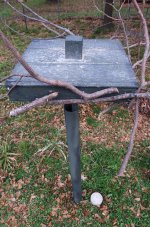Avon Avians
Well-known member

Hello folks!
My question is pretty straightforward, I guess, and kind of speaks for itself.
Nonetheless, I will go into more detail.
Our backyard in New Hampshire has a fair abundance of black-capped chickadees, white-breasted nuthatches, downy woodpeckers, and hairy woodpeckers.
Although I enjoy watching them from where they hang out, unfortunately we don't have any trees near our house to watch the birds from a closer perspective.
The simple solution would be to plant more trees. However, many trees take a rather long time to grow very tall, and I'm not sure if they would attract birds as saplings.
I know that the best trees (and shrubs) for attracting birds are those that bear fruit or nuts.
But again, the problem is that many species take several years to produce yields of edible fruits or nuts.
Oaks, for example, can take several years, often over 20 years, to produce acorns, and we can't exactly plant a 19 year-old oak in our yard.
So to summarize, I guess what I'm asking is are there any trees or tall shrubs that attract birds like chickadees, woodpeckers and nuthatches within a short period or time?
I know that chickadees are rather easy to please in terms of cover, but I believe that nuthatches and woodpeckers generally prefer taller areas to shelter.
Or are there any other ways to attract these birds to the front of our house that don't take several years?
I know that some poplars grow insanely fast, but people generally advise against planting those.
(For those living outside of North America, advice on attracting their Eurasian contemporaries like tits and spotted woodpeckers will probably be helpful, too.)
Any advice would be appreciated. Thanks! God bless!
My question is pretty straightforward, I guess, and kind of speaks for itself.
Nonetheless, I will go into more detail.
Our backyard in New Hampshire has a fair abundance of black-capped chickadees, white-breasted nuthatches, downy woodpeckers, and hairy woodpeckers.
Although I enjoy watching them from where they hang out, unfortunately we don't have any trees near our house to watch the birds from a closer perspective.
The simple solution would be to plant more trees. However, many trees take a rather long time to grow very tall, and I'm not sure if they would attract birds as saplings.
I know that the best trees (and shrubs) for attracting birds are those that bear fruit or nuts.
But again, the problem is that many species take several years to produce yields of edible fruits or nuts.
Oaks, for example, can take several years, often over 20 years, to produce acorns, and we can't exactly plant a 19 year-old oak in our yard.
So to summarize, I guess what I'm asking is are there any trees or tall shrubs that attract birds like chickadees, woodpeckers and nuthatches within a short period or time?
I know that chickadees are rather easy to please in terms of cover, but I believe that nuthatches and woodpeckers generally prefer taller areas to shelter.
Or are there any other ways to attract these birds to the front of our house that don't take several years?
I know that some poplars grow insanely fast, but people generally advise against planting those.
(For those living outside of North America, advice on attracting their Eurasian contemporaries like tits and spotted woodpeckers will probably be helpful, too.)
Any advice would be appreciated. Thanks! God bless!





